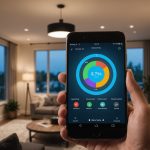Overview of Voice Technology in Smart Home Lighting
Voice technology has seen remarkable advancements, particularly in the realm of smart home lighting. It refers to using spoken commands to control various devices, a feature powered predominantly by smart speakers. The evolution of voice technology has brought significant enhancements in how we manage lighting in our homes, transforming traditional switch-based systems into intuitive voice-controlled experiences.
With the integration of voice control into smart home lighting, users can perform tasks such as turning lights on or off, dimming them, or even changing their colours simply through voice commands. This convenience has had a profound impact on both accessibility and energy efficiency, allowing for seamless lighting management.
Also read : Master Your Smart Home: Effortlessly Command Your Water Heater from Your Smartphone
There are several types of voice assistants that play a crucial role in managing smart home lighting. Popular assistants like Amazon Alexa, Google Assistant, and Apple’s HomeKit each provide unique features and capabilities. They all connect with smart lighting systems, offering compatibility with a wide range of products. By understanding the specific roles and compatibilities of these assistants, users can make informed decisions to enhance their home automation experiences.
Setting Up Voice Technology for Smart Lighting
To ensure a seamless integration of smart lights with voice technology, it is crucial to understand the necessary setup instructions. Firstly, you need compatible hardware and software. This typically includes a smart speaker or a display with voice assistant capability and smart light bulbs or fixtures from a supported brand. Make sure that both the voice assistant and smart lights are connected to your Wi-Fi network.
Also read : Revolutionizing Senior Care: Turn Your Smartphone into an Innovative Home Management Center
Step-by-Step Guide to Connect Smart Lights
-
Install the Smart Light: Position your smart light in the desired location and ensure it has power.
-
Download the Appropriate App: Most smart lights require a manufacturer-specific app. Create an account and link your device.
-
Enable the Voice Assistant Skill: For integration, activate the skill or service corresponding to your voice assistant. This is often found in the settings of the assistant app.
-
Pair Devices: Use the app to discover new devices. A successful pairing allows voice command setups such as “turn on the lights”.
Common issues during setup include connection errors or unresponsive lights. Solutions typically involve ensuring proximity to the router, using the correct Wi-Fi frequency, and power cycling both the smart light and speaker. If problems persist, checking manufacturer’s forums for guidance can be beneficial.
Popular Voice Assistants for Smart Lighting
Voice assistants have revolutionized the way we manage smart lighting, with each offering unique features that enhance user experience.
Google Assistant and Smart Lighting
Google Assistant stands out with its user-friendly integration and wide compatibility with various lighting brands. It offers impressive flexibility, allowing users to set routines, adjust brightness, and change colours seamlessly. The assistant’s strength lies in its ability to integrate smoothly with Google’s ecosystem, encompassing an extensive range of devices.
Amazon Alexa and Smart Lighting
Amazon Alexa is another major player, praised for its robust command recognition and vast selection of skills. Alexa excels in creating custom routines and managing multiple devices, making it a versatile choice for complex setups. Users appreciate its seamless integration with Amazon devices, offering a comprehensive smart home experience.
Apple HomeKit and Smart Lighting
For Apple HomeKit users, the compatibility with Apple’s ecosystem is a significant advantage. HomeKit focuses heavily on privacy and security, providing a reliable setup for smart lighting control. While its device compatibility is more limited compared to Google and Amazon, HomeKit users enjoy a unified and secure interface across Apple products, ensuring consistent performance.
Voice Commands for Smart Lighting Control
In the realm of smart lighting control, voice commands have revolutionized how homeowners manage their lighting systems. Essential voice commands, such as “turn on the lights” or “dim the bedroom lights,” allow for swift lighting adjustments, enhancing convenience and accessibility. These commands are the backbone of lighting automation, enabling users to manage their environment effortlessly.
Beyond basic commands, advanced voice functionalities empower users to create complex schedules and scenes. By instructing your voice assistant to “set a reading scene” or “schedule bedtime lighting,” you can automate your home lighting to cater to specific routines or moods. This level of lighting automation not only adds comfort but also improves energy efficiency and personalizes the user experience.
Personalizing voice commands enhances user interaction further. By naming specific devices or groups, like “turn on Alice’s lamp,” users gain more precise control over their lighting systems. Customizing these commands to fit personal preferences elevates the smart lighting automation experience, making it uniquely tailored to each user.
With evolving technology, staying updated with the latest commands can help users maximize their smart lighting systems’ potential and improve overall user experience. This continuous learning ensures that the setup remains effective and aligned with lifestyle changes.
Troubleshooting Common Issues
Navigating voice technology issues in smart lighting can be challenging but manageable with the right approach. One common problem users face is connectivity; often, voice assistants fail to recognize or respond to commands due to network disruptions. For seamless performance, ensure that both your smart lighting and voice assistants are connected to a stable Wi-Fi network. Using a dedicated frequency, such as 2.4 GHz, often helps improve connections.
Another common issue is unresponsive light devices, which may result from outdated software. Regularly update your smart lights and voice assistant apps to maintain smooth operation. Power cycling—turning devices off and back on—can resolve occasional glitches, restoring proper functionality.
To troubleshoot smart lighting problems related to voice recognition, ensure your voice assistant is trained to understand your accent. Many systems allow for voice training to enhance accuracy. If the problem persists, verify that device names are easy to pronounce and not excessively similar, avoiding confusion.
For optimal performance, keep distances between devices minimal, ensuring minimal obstructions. Employing these solutions effectively should enhance smart lighting experiences, facilitating reliable command execution and efficient lighting management. Regular maintenance empowers users to leverage the full potential of their voice technologies.
Best Practices for Optimizing Voice-Controlled Lighting
Optimizing your voice-controlled lighting not only enhances user experience but also maximizes energy efficiency. Here are some best practices to ensure your smart lighting system operates smoothly and effectively.
Organize Your Devices: Group your smart lighting devices logically by room or function. This organization simplifies control, making it easier to manage them through voice commands. For instance, creating groups like “kitchen lights” or “living room lamps” streamlines the process, allowing you to activate multiple devices with a single command.
Regular Updates: Keep your voice assistants and smart lighting apps up-to-date. Regular updates often include performance improvements and bug fixes, ensuring optimal functionality. Schedule periodic checks for software updates to maintain system efficiency.
Leverage Routines and Automations: Utilizing routines and automations can significantly enhance convenience. Set routines to match your daily activities, such as automatic dimming in the evening or turning off all lights at bedtime. These automations not only simplify your daily routine but also promote energy savings.
By implementing these practices, your voice-controlled smart lighting can become a more efficient and user-friendly aspect of your home, contributing to both a superior user experience and responsible energy usage.
Visual Aids and Resources for Users
Implementing smart lighting can be a transformative enhancement to your living space, and having access to visual guides can greatly streamline the process. Charts and infographics offer step-by-step guidance, assisting users in understanding how to set up and manage their lighting systems using voice technology. These visual aids can simplify complex information, making the process more approachable even for beginners.
When selecting smart lighting products, it is beneficial to consider those most compatible with prevalent voice technology platforms such as Google Assistant, Amazon Alexa, and Apple HomeKit. Choosing products known for their reliability and user-friendliness can enhance both the setup and ongoing user experience.
Beyond product recommendations, exploring online communities and resources can be incredibly advantageous. Numerous forums and websites feature reviews, user experiences, and shared solutions to common issues. Engaging with these communities allows users to stay informed about the latest updates in voice-controlled smart lighting and benefit from collective knowledge.
Incorporating these practices not only aids in optimally utilizing smart lighting systems but also supports users in making informed decisions. These resources provide ongoing support, ensuring one’s smart home setup remains efficient and enjoyable.











